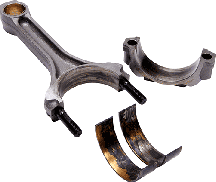It comes up quite often when an engine fails in a race car. The problem typically begins with a sudden loss of performance. After checking a few things, it appears that the engine has a serious problem when a significant amount of bearing debris is found during an oil filter inspection. The engine must then be removed from the car, torn down, diagnosed, and repaired. The intake manifold and cylinder heads are removed first and the short block is then completely disassembled as it will require a complete clean-up, regardless of what’s found.
When the engine is torn down under these circumstances, it’s typical that there is so much related damage that it becomes difficult to identify the cause of the initial failure, creating a true “chicken or the egg” issue. When a failure occurs, a “snowball effect” of sorts takes the engine by storm and what initially may have begun as a connecting rod bearing failure soon destroys the connecting rod, crankshaft, and all of the engine bearings in short order.
If the engine is run for any length of time in this condition, the bearing debris quickly circulates through the oiling system and is slung throughout the crankcase, damaging the camshaft and lifters. Bearing debris is also thrown up into the cylinders, where it quickly scores the piston skirts and damages the rings. When this has occurred, the entire rotating assembly may be ready for the trash heap.

In this particular instance, the connecting rod bearing spun, damaging the bearings, connecting rod, and crankshaft. What occurred first? Was the failure caused by detonation, overloading, oil breakdown, or connecting rod failure? This is a situation where proper diagnosis is critical in preventing future problems. It’s very likely that the oil wedge broke down, causing the bearing to fail and ultimately spin in the rod housing. However, did the oil wedge break down because of an oil-related issue, or did the big end of the connecting rod become distorted due to overloading and/or detonation, which then caused the oil wedge breakdown?
When the oil wedge breaks down and the bearing begins to actually physically contact the crankshaft, it quickly destroys the babbitt and copper layers of the bearing, and proceeds to tear into the steel backing. Lack of lubrication and the resulting intense friction lead to skyrocketing component temperatures that cause the bearing to begin to literally weld itself to the crankshaft, causing the bearing to break free from the locating lugs and spin within the connecting rod housing.
Unfortunately, this entire process can transpire very quickly in a race engine and can cost thousands of dollars to repair. Once properly diagnosed and with the necessary components repaired or replaced, however, the engine can be reassembled and put back into service without worry. Prior to reassembly, the block and all oiling system components must be cleaned thoroughly, and the oil pump pickup replaced. After a failure, the pickup is typically loaded with bearing debris that is nearly impossible to remove and these contaminants certainly don’t belong in a repaired engine.
Diagnosis of failures like these can be simplified by acquiring a book such as the “Engine Bearing Failure Analysis Guide” offered by Mahle/Clevite in PDF form on their website. It features a complete analysis of premature engine failures as well as corrective actions. It includes illustrations and photos of both normal bearing wear and failures caused by dirt and foreign particles, insufficient or excessive bearing crush, misassembly, misalignment (bent/twisted connecting rod, bent crankshaft or distorted crankcase), insufficient lubrication, overloading, corrosion (coolant/fuel in oil), and improper journal finish. Each diagnosis includes examples of bearing appearance, damaging action, possible causes, and necessary corrective action.
When inspecting engine bearings, understand that the upper rod bearing inserts and lower main bearings are subject to increased wear and loading when compared to their counterparts, due to the fact that the pistons and connecting rods are literally trying to force the crankshaft out of the block during the combustion process. Thrust bearings, in particular, should be carefully scrutinized as they can be very costly to repair. Thrust bearing failure can be caused by a variety of things including insufficient or excessive crankshaft end play, a ballooned torque converter, or stress caused by excessive clutch use.
According to the experts at Mahle/Clevite, nearly 50% of premature engine failures are caused by dirt and foreign particles. Many failures triggered by multiple factors such as overloading and detonation, for example, are common to racing. Although engine bearing failure is never welcome, it’s bound to happen to even the best racing engine programs eventually. When it happens, proper diagnosis and prevention is the key to future success.
The guide also includes recommendations concerning bearing installation tolerances, crankshaft grinding, and polishing